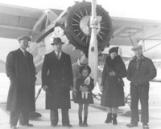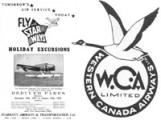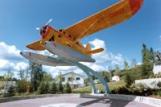1
Aviation played a major role in Red Lake’s early development and continues to be a big part of the community’s identity today.3
When gold was discovered in Red Lake, the only planes flying in the area were the Curtiss HS-2L Flying Boats. Operated by the Ontario Provincial Air Service, the planes were used for mapping and fire detection.In the fall of 1925, Jack Hammell, promoter for the Howey Gold Syndicate, chartered five Flying Boats to fly supplies to the Red Lake mining camp. This was the beginning of both winter and summer aviation in Canada. The highly skilled pilots, who were working seasonally for the government, were now in great demand by the budding commercial aviation industry.
5
Lured by the romance and adventure of bush flying, young men and women flocked to the area. Many of these aviation pioneers, such as Doc Oaks and Punch Dickins, went on to become some of Canada’s best known and respected airmen.7
Business was booming for Starratt Transportation Company and Western Canada Airways, two operators in the area. Based in Hudson, the jumping-off point to the mining camps, both companies competed to supply the mines and their growing communities.In 1934, the price of gold rose from $20 to $35/oz, resulting in increased mining activity in Red Lake. By the mid ’30s, the bush plane was dominating travel to the goldfields, and in the summer of 1936, with aircraft landing at 15 minute intervals, Red Lake, Gold Pines and Hudson became the busiest airports in the world.
The formation of Western Canada Airways in Hudson in 1926, as a result of the Red Lake Gold Rush, made a lasting impact on air travel in Canada. It evolved into Canadian Airways and later CP Air and Canadian Airlines.
8
The first commercial passenger flight to Red Lake3 March 1926
Red Lake, Northwestern Ontario, Canada

9
Red Lake’s first commercial passenger flight took place on March 3, 1926. Pilots Jack Elliott and Harold Farrington, each carrying one passenger, flew two Curtiss Canucks from Hudson to Red Lake. With only a compass to chart their course, they landed on Howey Bay in several feet of deep snow.Taking off from Howey Bay posed a major challenge, though. A crew of Native people was hired to pack a runway about a mile long until a hard crust made it possible for the planes to take off. The men then lifted the planes onto the strip and the pilots began the return flight.
Meanwhile, a crew was hard at work in Hudson marking the runway for the planes arrival. When they did not arrive back at their expected time, they lined the runway with gasoline-soaked rags so the planes could land safely after dark.
Mr. Elliott later commented that had it not been for the ingenuity and resourcefulness of the people in Red Lake and Hudson, there might have been a very different ending to Red Lake’s first commercial flight.



